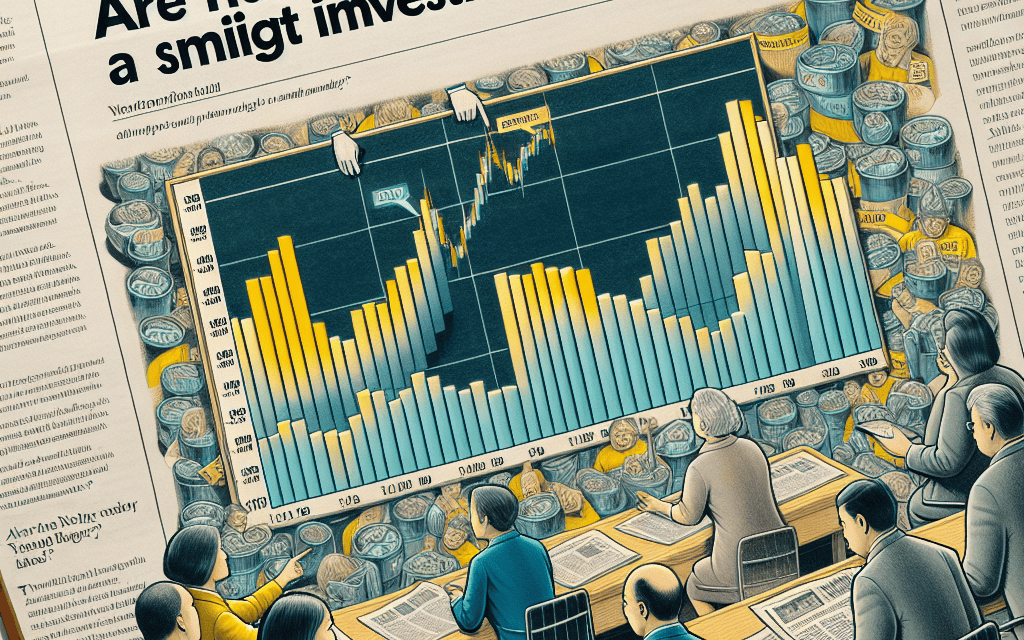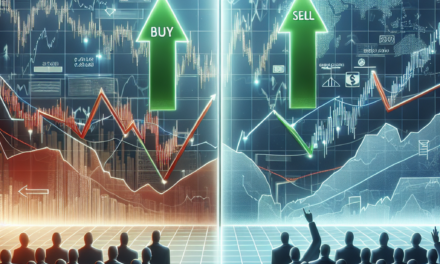“Stable Uranium Prices: Power Up Your Portfolio with Nuclear-Energy ETFs!”
Introduction
Uranium prices have recently shown a period of stability, prompting investors to reassess the potential of nuclear-energy-focused exchange-traded funds (ETFs) as a viable investment opportunity. As the global energy landscape shifts towards cleaner and more sustainable sources, nuclear energy is gaining renewed attention for its ability to provide reliable and low-carbon power. This stability in uranium prices could signal a favorable environment for nuclear-energy ETFs, which offer investors exposure to companies involved in uranium mining, nuclear power generation, and related technologies. With geopolitical factors, regulatory changes, and technological advancements influencing the sector, the question arises: Are nuclear-energy ETFs a smart investment choice in the current market climate?
Understanding Uranium Price Stability: Implications for Investors
Uranium prices have demonstrated a remarkable steadiness in recent months, a development that has captured the attention of investors and analysts alike. This stability comes at a time when the global energy landscape is undergoing significant transformations, with nuclear energy being increasingly recognized as a viable solution to the dual challenges of energy security and carbon emissions reduction. As a result, the question arises: are nuclear-energy exchange-traded funds (ETFs) a smart investment now?
To understand the implications of uranium price stability for investors, it is essential to first consider the factors contributing to this phenomenon. The global demand for uranium is largely driven by the nuclear power industry, which relies on this element as a critical fuel source. In recent years, there has been a resurgence of interest in nuclear energy, driven by the need for reliable and low-carbon energy sources. Countries such as China and India are expanding their nuclear power capabilities, while others, like France and the United States, are investing in the modernization of existing facilities. This sustained demand has played a crucial role in maintaining uranium prices at stable levels.
Moreover, the supply side of the uranium market has also contributed to price stability. Major uranium-producing countries, including Kazakhstan, Canada, and Australia, have managed their production levels carefully, ensuring that supply does not outstrip demand. This balance has been further supported by the strategic stockpiling of uranium by several nations, which acts as a buffer against potential supply disruptions. Consequently, the equilibrium between supply and demand has fostered a stable pricing environment.
For investors, the stability of uranium prices presents both opportunities and challenges. On one hand, the steady prices provide a level of predictability that can be appealing to those looking to invest in nuclear-energy ETFs. These funds offer exposure to a diversified portfolio of companies involved in the nuclear energy sector, including uranium miners, nuclear power plant operators, and technology providers. The stability in uranium prices can translate into more predictable earnings for these companies, potentially leading to more stable returns for investors.
On the other hand, it is important for investors to consider the broader context of the energy market. While nuclear energy is gaining traction, it is not without its challenges. Public perception, regulatory hurdles, and the high costs associated with building and maintaining nuclear power plants are factors that could impact the growth of the sector. Additionally, the rise of renewable energy sources, such as wind and solar, presents competition for nuclear energy, which could influence the long-term demand for uranium.
In light of these considerations, investors should approach nuclear-energy ETFs with a balanced perspective. While the stability of uranium prices is a positive indicator, it is crucial to conduct thorough research and consider the potential risks and rewards associated with this investment. Diversification remains a key strategy, as it allows investors to mitigate risks while capitalizing on the potential growth of the nuclear energy sector.
In conclusion, the steadiness of uranium prices offers a promising backdrop for those considering investments in nuclear-energy ETFs. However, as with any investment, it is essential to weigh the potential benefits against the inherent risks. By staying informed and adopting a strategic approach, investors can make well-informed decisions that align with their financial goals and risk tolerance.
The Role of Nuclear Energy in a Diversified Investment Portfolio
In recent years, the global energy landscape has been undergoing a significant transformation, with increasing emphasis on sustainable and low-carbon energy sources. Amidst this shift, nuclear energy has re-emerged as a viable option for meeting the world’s growing energy demands while minimizing carbon emissions. As a result, uranium prices have stabilized, prompting investors to consider the potential of nuclear-energy exchange-traded funds (ETFs) as a strategic addition to a diversified investment portfolio. Understanding the role of nuclear energy within such a portfolio requires a nuanced analysis of its benefits and risks.
Nuclear energy, known for its ability to generate large amounts of electricity with minimal greenhouse gas emissions, offers a compelling case for inclusion in an investment strategy focused on sustainability. Unlike fossil fuels, nuclear power plants produce electricity without emitting carbon dioxide during operation, making them an attractive option for countries striving to meet international climate commitments. This environmental advantage, coupled with the increasing global demand for clean energy, has led to renewed interest in nuclear power as a cornerstone of future energy systems.
Moreover, the stability of uranium prices in recent times has further bolstered the case for nuclear-energy ETFs. Unlike the volatile swings often seen in oil and gas markets, uranium prices have shown relative steadiness, providing a more predictable investment environment. This stability can be attributed to a combination of factors, including long-term supply contracts, advancements in nuclear technology, and geopolitical considerations that limit the number of uranium-producing countries. Consequently, investors seeking to mitigate risk while capitalizing on the growth potential of clean energy may find nuclear-energy ETFs to be an appealing option.
However, it is essential to recognize the inherent risks associated with investing in nuclear energy. Public perception and regulatory challenges continue to pose significant hurdles for the industry. High-profile nuclear accidents, such as those at Chernobyl and Fukushima, have left a lasting impact on public opinion, leading to stringent safety regulations and, in some cases, the phasing out of nuclear power in certain regions. These factors can influence the performance of nuclear-energy ETFs, as regulatory changes and shifts in public sentiment may affect the operational landscape for nuclear power companies.
Despite these challenges, the potential for technological advancements in nuclear energy cannot be overlooked. Innovations such as small modular reactors (SMRs) and advancements in nuclear waste management hold promise for enhancing the safety and efficiency of nuclear power. These developments could pave the way for a more favorable regulatory environment and increased public acceptance, thereby boosting the prospects of nuclear-energy investments.
In conclusion, the role of nuclear energy in a diversified investment portfolio is multifaceted, offering both opportunities and challenges. The steady uranium prices and the growing emphasis on clean energy provide a strong foundation for considering nuclear-energy ETFs as part of a broader investment strategy. However, investors must remain cognizant of the risks associated with public perception and regulatory changes. By carefully weighing these factors, investors can make informed decisions about the inclusion of nuclear energy in their portfolios, potentially benefiting from the long-term growth prospects of this critical energy source. As the world continues to navigate the complexities of the energy transition, nuclear energy may well play a pivotal role in shaping a sustainable and diversified investment landscape.
Analyzing the Performance of Nuclear-Energy ETFs Amid Steady Uranium Prices
As the global energy landscape continues to evolve, the role of nuclear energy has become increasingly significant, particularly in the context of reducing carbon emissions and ensuring energy security. In recent months, uranium prices have shown a remarkable steadiness, prompting investors to consider the potential of nuclear-energy exchange-traded funds (ETFs) as a viable investment option. This stability in uranium prices can be attributed to a combination of factors, including consistent demand from existing nuclear power plants and a cautious approach to new mining projects. Consequently, the performance of nuclear-energy ETFs has garnered attention from investors seeking to diversify their portfolios and capitalize on the long-term prospects of nuclear energy.
To understand the potential of nuclear-energy ETFs, it is essential to examine the underlying factors contributing to the steady uranium prices. One of the primary drivers is the sustained demand for uranium from countries that rely heavily on nuclear power, such as France, the United States, and China. These nations have continued to invest in nuclear energy infrastructure, recognizing its role in achieving energy independence and meeting climate goals. Additionally, the global push towards cleaner energy sources has led to a renewed interest in nuclear power, further supporting uranium demand.
Moreover, the supply side of the uranium market has been characterized by a cautious approach to new mining projects. Many mining companies have been reluctant to expand production capacity due to the historically volatile nature of uranium prices and the significant capital investment required for new projects. This cautious stance has helped maintain a balance between supply and demand, contributing to the current price stability. As a result, nuclear-energy ETFs, which often include a mix of uranium mining companies and nuclear power utilities, have shown resilience in their performance.
Investors considering nuclear-energy ETFs should also take into account the broader economic and geopolitical factors that could influence the sector. For instance, the ongoing global energy transition, driven by the need to reduce carbon emissions, is likely to bolster the long-term prospects of nuclear energy. Governments worldwide are increasingly recognizing the importance of nuclear power as a reliable and low-carbon energy source, which could lead to favorable policy environments and increased investment in the sector. Furthermore, geopolitical tensions and energy security concerns may prompt countries to diversify their energy sources, potentially increasing the demand for nuclear power and, by extension, uranium.
However, it is important to acknowledge the risks associated with investing in nuclear-energy ETFs. The sector is not immune to challenges, such as regulatory hurdles, public perception issues, and the potential for technological advancements in alternative energy sources. These factors could impact the growth trajectory of nuclear energy and, consequently, the performance of related ETFs. Therefore, investors should conduct thorough research and consider their risk tolerance before committing to this investment avenue.
In conclusion, the steady uranium prices present a compelling case for considering nuclear-energy ETFs as a smart investment option. The combination of sustained demand, cautious supply expansion, and favorable macroeconomic trends suggests that the sector may offer attractive long-term growth potential. Nevertheless, investors should remain vigilant and consider the inherent risks associated with the nuclear energy industry. By carefully weighing these factors, investors can make informed decisions about incorporating nuclear-energy ETFs into their investment portfolios, potentially benefiting from the evolving dynamics of the global energy market.
Long-Term Prospects for Uranium Investments in the Energy Sector

The long-term prospects for uranium investments in the energy sector have garnered significant attention as the world increasingly shifts towards sustainable energy solutions. With uranium prices remaining steady, investors are keenly evaluating the potential of nuclear-energy exchange-traded funds (ETFs) as a viable investment option. This interest is driven by the global push to reduce carbon emissions and the recognition of nuclear energy as a low-carbon power source. As countries strive to meet their climate goals, nuclear energy is being reconsidered as a critical component of the energy mix, offering a reliable and efficient alternative to fossil fuels.
In recent years, the stability of uranium prices has been a focal point for investors. Unlike the volatility seen in other commodities, uranium has maintained a relatively steady price range, providing a sense of predictability for those looking to invest in the sector. This stability is largely attributed to the consistent demand for nuclear energy, which is expected to grow as more countries commit to reducing their carbon footprints. Furthermore, the development of advanced nuclear technologies, such as small modular reactors, promises to enhance the safety and efficiency of nuclear power, potentially increasing its appeal as a sustainable energy source.
Transitioning to the investment landscape, nuclear-energy ETFs have emerged as a popular vehicle for those looking to capitalize on the potential growth of the uranium market. These ETFs offer a diversified approach, allowing investors to gain exposure to a broad range of companies involved in the nuclear energy supply chain, from uranium mining to reactor construction and operation. This diversification can mitigate some of the risks associated with investing in individual stocks, making ETFs an attractive option for those seeking to invest in the long-term prospects of the nuclear energy sector.
Moreover, the geopolitical landscape plays a crucial role in shaping the future of uranium investments. As countries seek to secure their energy independence, the demand for domestically sourced uranium is likely to increase. This trend is particularly evident in regions with limited access to other forms of energy, where nuclear power can provide a stable and reliable energy supply. Additionally, international agreements and collaborations aimed at promoting nuclear energy development could further bolster the market, creating new opportunities for investors.
However, it is essential to consider the challenges that may impact the long-term prospects of uranium investments. Public perception of nuclear energy remains a significant hurdle, with concerns about safety and waste management continuing to influence policy decisions. While technological advancements have addressed many of these issues, gaining public trust remains a critical factor in the widespread adoption of nuclear power. Furthermore, regulatory changes and political shifts can introduce uncertainties that may affect the stability of uranium prices and the performance of nuclear-energy ETFs.
In conclusion, the steady prices of uranium and the growing recognition of nuclear energy as a sustainable power source present compelling reasons for investors to consider nuclear-energy ETFs. The long-term prospects for uranium investments appear promising, driven by the global transition towards low-carbon energy solutions and the development of advanced nuclear technologies. However, investors must remain cognizant of the challenges and uncertainties that could impact the sector. By carefully evaluating these factors, investors can make informed decisions about the potential of uranium investments in the evolving energy landscape.
Comparing Nuclear-Energy ETFs: Which Offers the Best Value?
As the global energy landscape continues to evolve, investors are increasingly turning their attention to nuclear energy as a viable and sustainable option. This shift is largely driven by the steady prices of uranium, the critical fuel for nuclear reactors, which have maintained a level of stability amidst the volatility seen in other energy markets. Consequently, nuclear-energy exchange-traded funds (ETFs) have emerged as a popular investment vehicle for those looking to capitalize on the potential growth of the nuclear sector. However, with several nuclear-energy ETFs available, determining which offers the best value requires a careful examination of their respective compositions, performance, and underlying strategies.
To begin with, it is essential to understand the fundamental differences between the various nuclear-energy ETFs. These funds typically comprise a mix of companies involved in uranium mining, nuclear power generation, and related technologies. Some ETFs may focus more heavily on uranium miners, while others might emphasize companies that are directly involved in the operation and development of nuclear power plants. This distinction can significantly impact the risk and return profile of each fund, as uranium mining companies are often more susceptible to fluctuations in commodity prices, whereas power generation firms may offer more stable cash flows.
In evaluating the performance of nuclear-energy ETFs, historical returns provide valuable insights. Over the past few years, many of these funds have delivered impressive returns, driven by a combination of rising demand for clean energy and geopolitical factors that have underscored the importance of energy security. However, past performance is not always indicative of future results, and investors should also consider the broader market conditions and potential regulatory changes that could impact the nuclear industry. For instance, increased government support for nuclear energy as part of climate change initiatives could bolster the prospects of these ETFs.
Another critical factor to consider is the expense ratio of each ETF. This metric represents the annual fee that investors pay to fund managers for managing the ETF. Lower expense ratios can enhance an investor’s net returns over time, making them an important consideration when comparing similar funds. Additionally, the liquidity of the ETF, which refers to how easily shares can be bought or sold without affecting the price, is another aspect that investors should not overlook. Highly liquid ETFs tend to have tighter bid-ask spreads, reducing the cost of trading.
Furthermore, diversification within the ETF is a key element that can influence its attractiveness. A well-diversified ETF that includes a broad range of companies across different segments of the nuclear energy industry can help mitigate risks associated with individual company performance. This diversification can be particularly beneficial in a sector that is subject to regulatory scrutiny and technological advancements.
In conclusion, while the steady prices of uranium present a compelling case for investing in nuclear-energy ETFs, selecting the right fund requires a comprehensive analysis of various factors. Investors should weigh the composition, historical performance, expense ratio, liquidity, and diversification of each ETF to determine which offers the best value. As the world continues to seek sustainable energy solutions, nuclear-energy ETFs may indeed represent a smart investment opportunity, provided that investors conduct thorough due diligence and align their choices with their individual risk tolerance and investment objectives.
The Impact of Global Energy Policies on Uranium and Nuclear Investments
The global energy landscape is undergoing a significant transformation, driven by the urgent need to address climate change and the quest for sustainable energy sources. As countries strive to reduce their carbon footprints, nuclear energy has re-emerged as a viable option due to its low greenhouse gas emissions. Consequently, uranium, the critical component for nuclear power generation, has garnered increased attention from investors. In this context, the stability of uranium prices has sparked discussions about the potential of nuclear-energy exchange-traded funds (ETFs) as a smart investment choice.
To understand the impact of global energy policies on uranium and nuclear investments, it is essential to consider the broader geopolitical and environmental factors at play. Many nations are revisiting their energy strategies, with some opting to phase out fossil fuels in favor of cleaner alternatives. This shift is particularly evident in Europe, where the European Union has set ambitious targets to achieve carbon neutrality by 2050. As part of this effort, several EU member states are investing in nuclear power, recognizing its ability to provide a stable and reliable energy supply while minimizing carbon emissions.
Similarly, in Asia, countries like China and India are expanding their nuclear power capabilities to meet growing energy demands and reduce air pollution. China’s commitment to building new reactors and India’s plans to increase its nuclear capacity underscore the region’s reliance on nuclear energy as a cornerstone of their energy policies. These developments have contributed to a steady demand for uranium, thereby stabilizing its prices in the global market.
However, the relationship between uranium prices and nuclear-energy ETFs is not solely dependent on demand. Supply-side dynamics also play a crucial role. The uranium market has experienced periods of oversupply, leading to price volatility. Nevertheless, recent production cuts by major uranium producers have helped balance the market, contributing to price stability. This equilibrium is crucial for investors considering nuclear-energy ETFs, as it reduces the risk associated with fluctuating uranium prices.
Moreover, the growing interest in nuclear energy is reflected in the performance of nuclear-energy ETFs. These investment vehicles offer exposure to a diversified portfolio of companies involved in the nuclear energy sector, including uranium miners, nuclear plant operators, and technology providers. As global energy policies increasingly favor nuclear power, these ETFs stand to benefit from the sector’s growth potential.
In addition to market dynamics, regulatory frameworks also influence the attractiveness of nuclear-energy ETFs. Governments worldwide are implementing policies to support the development of nuclear infrastructure, including streamlined licensing processes and financial incentives. Such measures enhance the investment climate for nuclear projects, potentially boosting the performance of related ETFs.
Nevertheless, investors must remain cognizant of the inherent risks associated with nuclear energy investments. Public perception and political opposition to nuclear power can impact policy decisions, leading to regulatory changes that may affect the sector’s growth prospects. Additionally, the long-term management of nuclear waste and the potential for accidents remain significant concerns that could influence investor sentiment.
In conclusion, the steady prices of uranium, coupled with supportive global energy policies, present a compelling case for considering nuclear-energy ETFs as a smart investment option. As countries continue to prioritize sustainable energy solutions, the nuclear sector is poised for growth, offering investors an opportunity to capitalize on this transition. However, it is imperative for investors to conduct thorough due diligence and remain vigilant of the evolving regulatory and market landscape to make informed investment decisions.
Risk and Reward: Evaluating the Potential of Nuclear-Energy ETFs
As the global energy landscape continues to evolve, investors are increasingly turning their attention to alternative energy sources, with nuclear energy emerging as a significant contender. The steady prices of uranium, a critical component in nuclear energy production, have sparked interest in nuclear-energy exchange-traded funds (ETFs) as a potential investment opportunity. However, evaluating the risk and reward associated with these ETFs requires a nuanced understanding of the factors influencing the nuclear energy sector.
To begin with, the stability in uranium prices can be attributed to a combination of supply and demand dynamics. On the supply side, production levels have been relatively consistent, with major producers maintaining output to meet global demand. Meanwhile, demand for uranium is driven by the ongoing operation and construction of nuclear power plants worldwide. Countries such as China and India are expanding their nuclear capabilities to meet growing energy needs while reducing carbon emissions. This steady demand supports the notion that uranium prices are unlikely to experience significant volatility in the near term.
In light of these factors, nuclear-energy ETFs present a compelling investment opportunity. These funds typically comprise a diversified portfolio of companies involved in various aspects of the nuclear energy industry, including uranium mining, nuclear power plant operation, and technology development. By investing in a nuclear-energy ETF, investors gain exposure to the entire value chain of the nuclear sector, potentially mitigating the risks associated with investing in individual stocks.
However, it is essential to consider the inherent risks associated with nuclear-energy ETFs. One of the primary concerns is the regulatory environment surrounding nuclear energy. Governments worldwide impose stringent regulations on nuclear power plants to ensure safety and environmental protection. Any changes in these regulations, such as increased safety requirements or shifts in energy policy, could impact the profitability of companies within the nuclear sector. Additionally, public perception of nuclear energy remains a contentious issue, with concerns about safety and waste disposal potentially influencing policy decisions.
Despite these challenges, the potential rewards of investing in nuclear-energy ETFs are significant. As the world grapples with the urgent need to transition to cleaner energy sources, nuclear power offers a reliable and low-carbon alternative to fossil fuels. The growing emphasis on reducing greenhouse gas emissions and achieving energy security is likely to drive further investment in nuclear technology and infrastructure. Consequently, companies within the nuclear sector may experience growth, benefiting investors in nuclear-energy ETFs.
Moreover, technological advancements in nuclear energy, such as the development of small modular reactors (SMRs) and improvements in waste management, could enhance the sector’s attractiveness. These innovations promise to address some of the longstanding concerns associated with nuclear power, potentially leading to broader acceptance and adoption.
In conclusion, while nuclear-energy ETFs present a promising investment opportunity, they are not without risks. Investors must carefully weigh the potential rewards against the challenges posed by regulatory changes and public perception. By staying informed about developments in the nuclear energy sector and considering the broader energy transition, investors can make more informed decisions about whether nuclear-energy ETFs align with their investment goals. As with any investment, a thorough analysis of market conditions and individual risk tolerance is essential to navigating the complexities of this dynamic sector.
Q&A
1. **What factors are influencing the steadiness of uranium prices?**
– Supply constraints, geopolitical tensions, and increasing demand for nuclear energy are key factors.
2. **How does the demand for nuclear energy impact uranium prices?**
– Rising demand for nuclear energy boosts uranium prices as more reactors require fuel.
3. **What are nuclear-energy ETFs?**
– Exchange-traded funds that invest in companies involved in the nuclear energy sector, including uranium mining and nuclear power production.
4. **Why might nuclear-energy ETFs be considered a smart investment now?**
– Stable uranium prices, growing interest in clean energy, and potential government support for nuclear power can make these ETFs attractive.
5. **What risks are associated with investing in nuclear-energy ETFs?**
– Regulatory changes, nuclear accidents, and fluctuations in uranium prices pose risks.
6. **How do geopolitical tensions affect uranium markets?**
– Tensions can disrupt supply chains and lead to price volatility, impacting uranium availability.
7. **What is the long-term outlook for uranium prices and nuclear-energy ETFs?**
– Positive, due to global shifts towards low-carbon energy sources and potential expansion of nuclear power capacity.
Conclusion
Uranium prices have remained stable, reflecting a balanced supply-demand dynamic in the nuclear energy sector. This stability, coupled with increasing global interest in clean energy solutions, suggests that nuclear-energy ETFs could be a prudent investment. As countries aim to reduce carbon emissions and diversify energy sources, nuclear power is gaining traction as a reliable and low-carbon option. Consequently, nuclear-energy ETFs, which track companies involved in uranium mining and nuclear technology, may offer investors exposure to this growing sector. However, potential investors should consider geopolitical risks, regulatory changes, and technological advancements that could impact the nuclear industry. Overall, while nuclear-energy ETFs present an attractive opportunity in the context of a transitioning energy landscape, thorough due diligence and risk assessment are essential.





